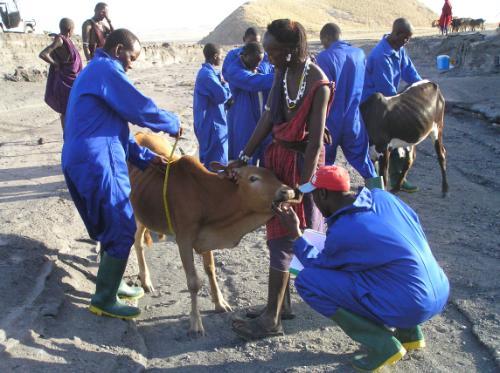Foot-and-mouth disease research to inform vaccine manufacturing and control options for East Africa
Published: 7 August 2015
Researchers from the Institute and The Pirbright Institute are collaborating with MSD Animal Health to strengthen surveillance capacity for foot-and-mouth disease (FMD) in rural Tanzania through community engagement and simple field-based diagnostics.
Researchers from the Institute and The Pirbright Institute are collaborating with MSD Animal Health to strengthen surveillance capacity for foot-and-mouth disease (FMD) in rural Tanzania through community engagement and simple field-based diagnostics.
Foot-and-mouth disease virus (FMDV) is one of the most important livestock pathogens globally. Economic consequences of the disease include reduced trading opportunities. Individual farmers are also severely affected due to a decrease in milk production, traction capacity, fertility and growth rates of infected animals. These impacts are particularly devastating in sub-Saharan Africa where FMD is widespread and poorly controlled, and local communities depend on livestock for their subsistence.
Previous research led by the Institute as part of the Combating Infectious Diseases of Livestock for International Development (CIDLID) initiative (UK Biotechnology and Biological Sciences Research Council, Department for International Development and the Scottish Government) demonstrated that drivers of infection in traditional production systems in Tanzania are livestock-related. Livestock vaccination is therefore expected to be an effective prevention approach, but its implementation is constrained by the unavailability of vaccines relevant to local circulating virus strains.
The close involvement of MSD Animal Health in our research in Tanzania will enable us to use data generated through improved surveillance for selection and development of vaccines tailored to the needs of affected communities in Tanzania and potentially other African countries. These data will also allow us to determine if outbreaks by a given virus type (there are four virus types known to be circulating in these communities) can be predicted, and control measures can therefore be timed.
Work with local communities in Tanzania has involved knowledge exchange processes aimed at enabling livestock owners and veterinary personnel to make use of research findings to develop FMD surveillance and prevention plans suitable for their settings. Livestock owners will also be provided with field-friendly diagnostic kits to obtain an immediate in situ diagnosis. Close engagement with communities has ensured their continuous involvement in the research and the establishment of a sense of ownership of research outputs.
First published: 7 August 2015
Find Out More:
Current Staff Involved in this Project:
Dr Tiziana Lembo
Dr Richard Reeve


